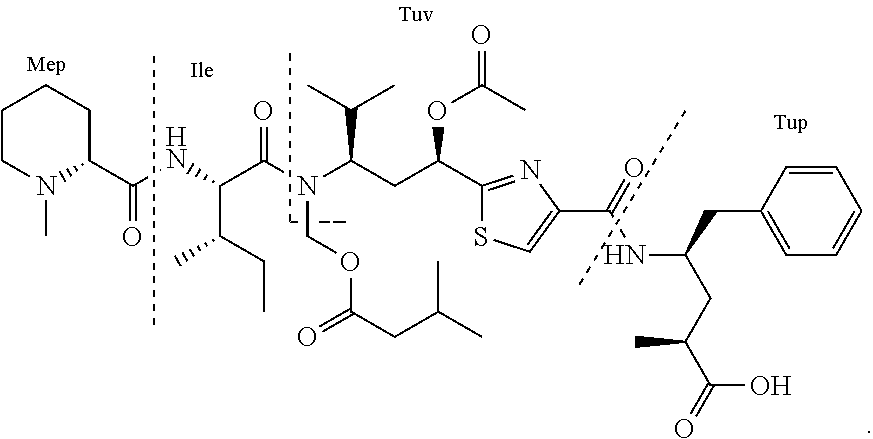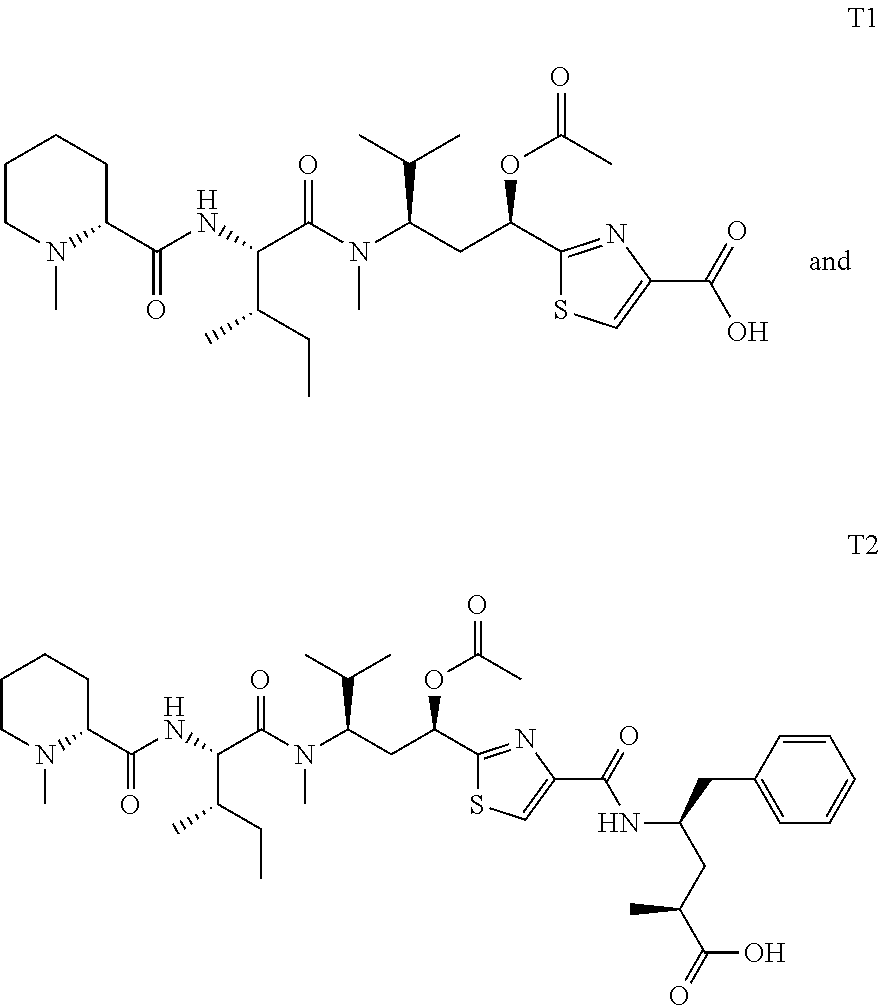Antibody-Drug Conjugates and Related Compounds, Compositions, and Methods
a technology of antibody and drug, applied in the field of antibody drug conjugates and related compounds, can solve the problems of high cost of goods, few effective treatment options beyond surgical resection, patients in this population that fail to respond or respond only poorly to herceptin treatment, etc., to achieve the effect of reducing the amount of cytotoxin, increasing half-lives, and increasing stability
- Summary
- Abstract
- Description
- Claims
- Application Information
AI Technical Summary
Benefits of technology
Problems solved by technology
Method used
Image
Examples
example 1
Synthesis of 3,4-bis(2-pyridylsulfanyl)pyrrole-2,5-dione
[0085]
[0086]3,4-Dibromopyrrole-2,5-dione [2,3-dibromomaleimide], 1 g, was added to a clean 100 mL round bottom flask with a rubber stopper and bubbler, and dissolved in 50 mL HPLC grade methanol. 2-Pyridinethiol, 2 equivalents, was added to a 20 mL scintillation vial, and dissolved in 10 mL methanol. Under nitrogen and with stirring, the 2-pyridinethiol / methanol solution was added dropwise to the 3,4-dibromopyrrole-2,5-dione via a 20 mL syringe with a 16 gauge needle, and the reaction mixture was stirred for an additional 3-4 hours. The methanol was evaporated and the crude product was dissolved in ethyl acetate and loaded onto about 2 g silica gel. The silica gel-loaded crude product was eluted through a 12 g silica gel cartridge with a hexane:ethyl acetate gradient from 9:1 to 0:1 over 25 column volumes. The enriched fractions were identified, pooled and lyophilized to dryness. The final product was recrystallized from ethyl ...
example 2
Synthesis of 39-(3,4-dibromo-2,5-dioxopyrrolyl)-3,6,9,12,15,18,21,24,27,30,33,36-dodecaoxanonatriacontanoic Acid:
[0088]
[0089]A 100 mL two-necked round bottom flask was flame dried and cooled under nitrogen. The cooled flask was charged with 200 mg (0.296 mmol) of tert-butyl 39-hydroxy-3,6,9,12,15,18,21,24,27,30,33,36-dodecaoxanonatriacontanoate. Triphenylphosphine, 106 mg, was dissolved in about 5 mL anhydrous tetrahydrofuran in a vial, and the solution was added to the 100 mL flask via cannula under nitrogen. The 100 mL flask was cooled in an ice-water bath for 15 minutes. To the cooled solution was added 55 mg (0.217 mmol) 3,4-dibromopyrrole-2,5-dione with stirring until a clear solution was observed. DIAD, 58.3 μL, was added to the cooled reaction mixture, which was stirred in the ice bath for an additional 10 minutes. The reaction mixture was stirred and allowed to reach room temperature over about 20 hours, then concentrated on a rotary evaporator until dry, giving a yellow vis...
example 3
Synthesis of 39-(3,4-dibromo-2,5-dioxopyrrolidinyl)-3,6,9,12,15,18,21,24,27,30,33,36-dodecaoxanonatriacontanoic Acid [the dBrPEG Linker]:
[0091]
[0092]39-(2,5-dioxopyrrolyl)-3,6,9,12,15,18,21,24,27,30,33,36-dodecaoxanonatriacontanoic acid was prepared in the same manner as the 39-(3,4-dibromo-2,5-dioxopyrrolyl)-3,6,9,12,15,18,21,24,27,30,33,36-dodecaoxanonatriacontanoic acid of Example 2, but starting with maleimide rather than 2,3-dibromomaleimide. The acid was treated with 0.5 equivalents of bromine in chloroform followed by refluxing overnight to give 39-(3,4-dibromo-2,5-dioxopyrrolidinyl)-3,6,9,12,15,18,21,24,27,30,33,36-dodecaoxanonatriacontanoic acid after flash purification on silica gel.
[0093]Similar syntheses may be performed using other hydroxyl-terminated sidechains, e.g. using tert-butyl 6-hydroxyhexanoate to give 6-(3,4-dibromo-2,5-dioxopyrrolidinyl)hexanoic acid, etc. The dibrominated linkers that are products of this synthesis may be dehydrobrominated with base in an ad...
PUM
 Login to View More
Login to View More Abstract
Description
Claims
Application Information
 Login to View More
Login to View More - R&D
- Intellectual Property
- Life Sciences
- Materials
- Tech Scout
- Unparalleled Data Quality
- Higher Quality Content
- 60% Fewer Hallucinations
Browse by: Latest US Patents, China's latest patents, Technical Efficacy Thesaurus, Application Domain, Technology Topic, Popular Technical Reports.
© 2025 PatSnap. All rights reserved.Legal|Privacy policy|Modern Slavery Act Transparency Statement|Sitemap|About US| Contact US: help@patsnap.com



